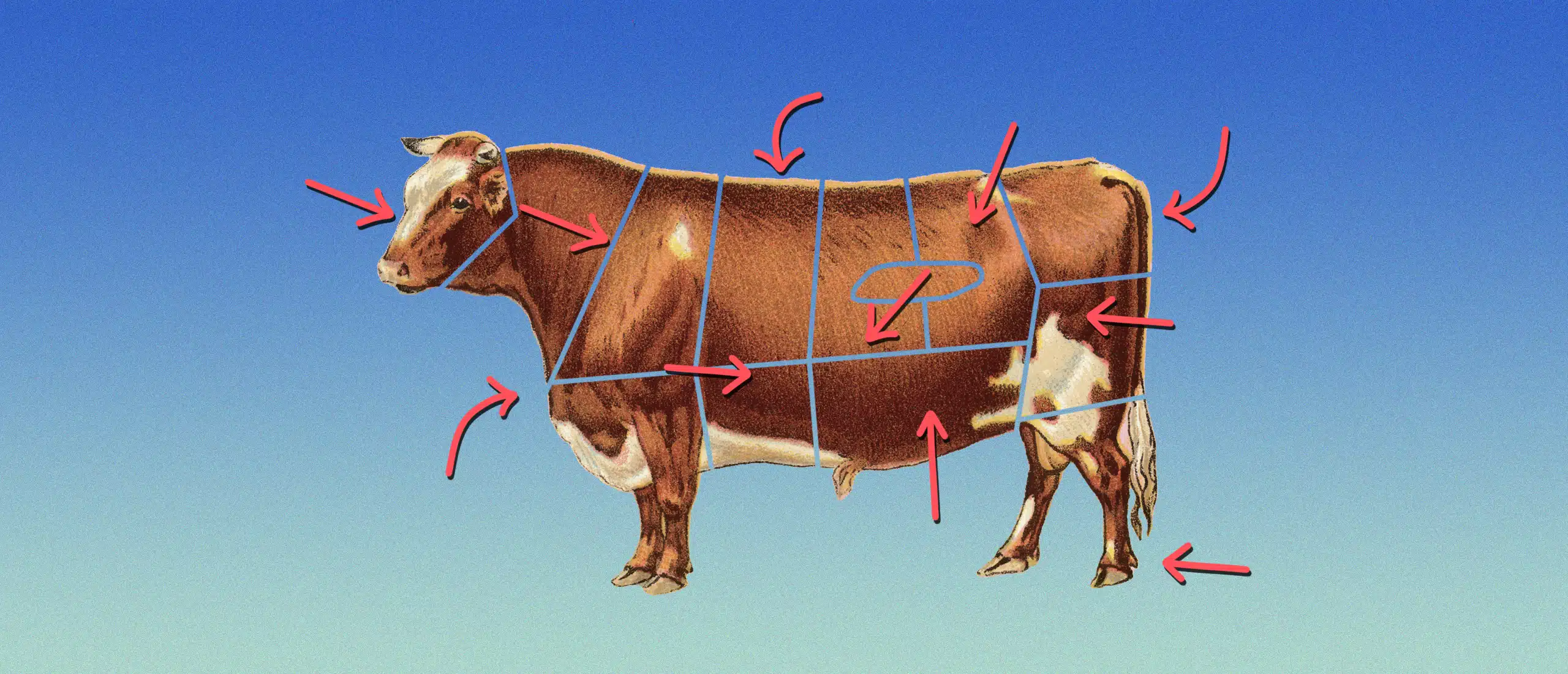Can Eating Nose to Tail Help You Live Longer?
Most of us watch in horror when the Liver King slobbers down raw bovine brains, guzzles a cup of blood Fear Factor-style, or goes to town on raw testicles. But the dude might be on to something.
Nose to tail eating (which is exactly what it sounds like) cuts down on food waste, reduces your environmental footprint, honors the animals that you eat, and packs in more nutrient-dense foods.
Nose to tail eating dates back to hunter-gatherers, who didn’t let any part of an animal they hunted go to waste. They ate the nutrient-rich organs, made bone broth out of the bones (which contains collagen), used the skin for garments and dietary fat, and leaned on tallow for lotion and cooking oil.
But is eating nose to tail healthy? Here’s the deal.
What is Nose to Tail Eating?
Eating nose to tail means using and enjoying the whole animal. A typical nose to tail diet incorporates off-cuts like organ meats, bones, marrow, connective tissue, skin, and tallow—scraps that often get sent straight to the landfill.
Western culture tends to choose lean choice cuts over the less sought-after parts of the animal. “Muscle meat might have more protein, but off-cuts are loaded with more vitamins and minerals. By eating both, you get the best of both worlds,” says registered dietician Melissa Sallee, RD.
Benefits of Nose to Tail Eating
A longer life
Choice cuts like chicken breast, steak, and pork chops are rich in methionine—an amino acid found in lean meat. Methionine helps keep your liver and hormones in check and may have antioxidant properties (1). Studies have also linked methionine restriction to a longer lifespan (2).
Scientists suspect this might due to methionine’s role in activating the mammalian target of rapamycin (mTOR) complex. When mTOR is activated, you build muscle. While muscle mass is essential for longevity (3), too much mTOR is linked to age-related diseases like diabetes and cancer (4, 5). When mTOR is downregulated, it activates a process called autophagy, which enhances cell performance, keeping you healthy (6).
Off-cuts like oxtail and organ meat, on the other hand, often contain connective tissue, tendons, ligaments, skin, cartilage, and bones that are packed in collagen—which is rich in the amino acid glycine.
Here’s where it gets interesting: Glycine may buffer methionine’s effect on the aging process. Preliminary studies have shown that dietary glycine increases the lifespan of worms, suppressing many genes involved in the aging process through altering methionine metabolism (7).
In humans, glycine supplementation has been shown to protect against chronic inflammation and oxidative stress (8). Elevated levels of blood glycine are associated with a reduced risk of cardiovascular disease (9), insulin sensitivity (10), and type 2 diabetes (11).
More nutrients
Organ meat is often higher in vitamins and minerals than choice cuts, says Sallee. The amount of each nutrient depends on the organ and the animal. But in general, they’re particularly rich in B vitamins (particularly B6 and B12), along with fat-soluble vitamins A, D, E, and K. Organ meat is also mineral-dense, packing high amounts of iron, magnesium, selenium, and zinc.
“Although ounce-for-ounce organ meats aren’t as high in protein as muscle meat (like chicken breast), they’re still a good source of protein,” Sallee adds. Unlike plant-based protein, organ meat offers high-quality protein covering all nine essential amino acids.
Here’s how a 3.5-ounce portion of cooked beef liver stacks up (12, 13):
- Calories: 191
- Protein: 29 grams
- Vitamin B12: 2715% of the Daily Value (DV)
- Copper: 1588% of the DV
- Vitamin A: 1048% of the DV
- Riboflavin: 263% of the DV
- Niacin: 109% of the DV
- Vitamin B6: 60% of the DV
- Selenium: 66% of the DV
- Zinc: 48% of the DV
- Iron: 36% of the DV
Less food waste
Eating meat isn’t so hot for the planet. Thirty four percent of greenhouse gases come from the food system, a major share of those coming from meat production, according to a study published in Nature (14).
One recent study estimated that by eating more offal, we would eat fewer animals overall, cutting greenhouse emissions by as much as 14 percent (15).
More money
Less popular cuts of meat cost less, plain and simple. You can snag organs like beef liver, kidney, or heart at a fraction of the cost of a prized ribeye or filet mignon.
Is Nose to Tail Eating Safe?
For the most part, yes. “Organ meat is safe for most people to eat in moderation,” says Sallee.
But there are a few caveats. “[Organ meat] is high in saturated fat which can increase your LDL cholesterol if eaten in excess.” Which is why if you have high cholesterol or are at risk of cardiovascular disease, Sallee recommends sticking with leaner cuts like chicken breast or turkey.
Gnawing on organs may also slightly increase your risk of developing non-alcoholic fatty liver disease (NAFLD), according to a recent study (16). Researchers noted more studies are needed to confirm their findings. “Still, you might want to skip on eating organ meat if you have type 2 diabetes or high cholesterol, both of which are risk factors for NAFLD,” says Sallee.
How to Start Eating Nose to Tail
Limit processed organ meat
“It’s important to remember not all organ meats are created equal,” says Sallee. In the U.S., the most common organ meats are found in the form of hot dogs and sausages, pork rinds, bone broth, and bone marrow.
“Processed meat like hot dogs, sausages, and fried pork rinds are often packed with preservatives which can bring down the overall quality of a food,” she adds.
Opt for organic, pasture-raised, grass-fed
Animals that eat from phytochemically rich landscapes are healthier. This in turn makes the meat and organs harvested from that animal more nutrient-dense (17). “If you’re looking to load up on vitamins and minerals, opt for organic, pasture-raised, grass-fed cuts when possible,” says Sallee.
Start small
There’s no need to go full Liver King here. “How you engage with nose to tail eating is a personal choice, and can fall on a spectrum,” says Sallee. “Start with small changes like cooking with tallow—a rendered form of fat that can be used in the place of butter or cooking oils—or looking to your butcher for guidance on the best off-cuts available in your local area.”
Get creative in the kitchen
If you are new to eating organ meat, the strong flavor and textures can be off-putting. “Try blending organ meats like liver or hearts into ground beef for burger patties, meatballs, or stirfries—you won’t even know it’s there,” Sallee says. She also recommends boiling bones with your favorite herbs and vegetables to make nourishing bone broth, which can be used as a nutrient-dense base for soups, stews, or sauces.













